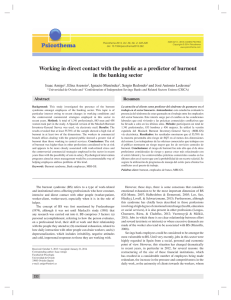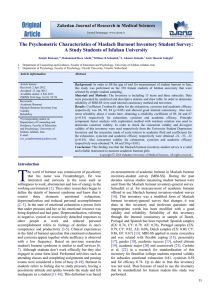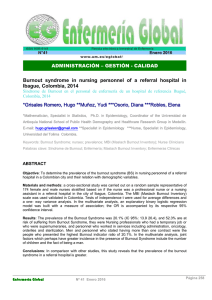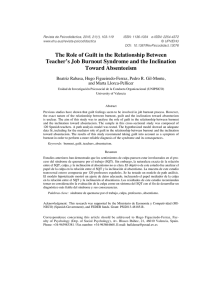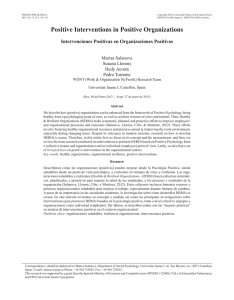Pág. 354 - Psicothema
Anuncio
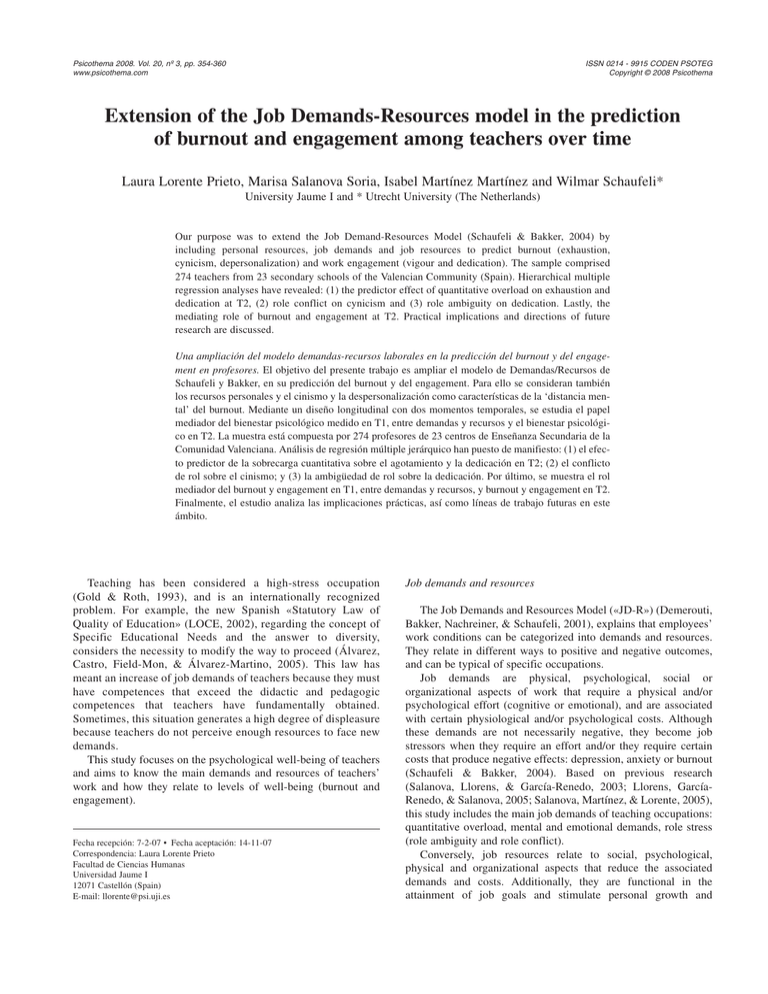
Psicothema 2008. Vol. 20, nº 3, pp. 354-360 www.psicothema.com ISSN 0214 - 9915 CODEN PSOTEG Copyright © 2008 Psicothema Extension of the Job Demands-Resources model in the prediction of burnout and engagement among teachers over time Laura Lorente Prieto, Marisa Salanova Soria, Isabel Martínez Martínez and Wilmar Schaufeli* University Jaume I and * Utrecht University (The Netherlands) Our purpose was to extend the Job Demand-Resources Model (Schaufeli & Bakker, 2004) by including personal resources, job demands and job resources to predict burnout (exhaustion, cynicism, depersonalization) and work engagement (vigour and dedication). The sample comprised 274 teachers from 23 secondary schools of the Valencian Community (Spain). Hierarchical multiple regression analyses have revealed: (1) the predictor effect of quantitative overload on exhaustion and dedication at T2, (2) role conflict on cynicism and (3) role ambiguity on dedication. Lastly, the mediating role of burnout and engagement at T2. Practical implications and directions of future research are discussed. Una ampliación del modelo demandas-recursos laborales en la predicción del burnout y del engagement en profesores. El objetivo del presente trabajo es ampliar el modelo de Demandas/Recursos de Schaufeli y Bakker, en su predicción del burnout y del engagement. Para ello se consideran también los recursos personales y el cinismo y la despersonalización como características de la ‘distancia mental’ del burnout. Mediante un diseño longitudinal con dos momentos temporales, se estudia el papel mediador del bienestar psicológico medido en T1, entre demandas y recursos y el bienestar psicológico en T2. La muestra está compuesta por 274 profesores de 23 centros de Enseñanza Secundaria de la Comunidad Valenciana. Análisis de regresión múltiple jerárquico han puesto de manifiesto: (1) el efecto predictor de la sobrecarga cuantitativa sobre el agotamiento y la dedicación en T2; (2) el conflicto de rol sobre el cinismo; y (3) la ambigüedad de rol sobre la dedicación. Por último, se muestra el rol mediador del burnout y engagement en T1, entre demandas y recursos, y burnout y engagement en T2. Finalmente, el estudio analiza las implicaciones prácticas, así como líneas de trabajo futuras en este ámbito. Teaching has been considered a high-stress occupation (Gold & Roth, 1993), and is an internationally recognized problem. For example, the new Spanish «Statutory Law of Quality of Education» (LOCE, 2002), regarding the concept of Specific Educational Needs and the answer to diversity, considers the necessity to modify the way to proceed (Álvarez, Castro, Field-Mon, & Álvarez-Martino, 2005). This law has meant an increase of job demands of teachers because they must have competences that exceed the didactic and pedagogic competences that teachers have fundamentally obtained. Sometimes, this situation generates a high degree of displeasure because teachers do not perceive enough resources to face new demands. This study focuses on the psychological well-being of teachers and aims to know the main demands and resources of teachers’ work and how they relate to levels of well-being (burnout and engagement). Fecha recepción: 7-2-07 • Fecha aceptación: 14-11-07 Correspondencia: Laura Lorente Prieto Facultad de Ciencias Humanas Universidad Jaume I 12071 Castellón (Spain) E-mail: llorente@psi.uji.es Job demands and resources The Job Demands and Resources Model («JD-R») (Demerouti, Bakker, Nachreiner, & Schaufeli, 2001), explains that employees’ work conditions can be categorized into demands and resources. They relate in different ways to positive and negative outcomes, and can be typical of specific occupations. Job demands are physical, psychological, social or organizational aspects of work that require a physical and/or psychological effort (cognitive or emotional), and are associated with certain physiological and/or psychological costs. Although these demands are not necessarily negative, they become job stressors when they require an effort and/or they require certain costs that produce negative effects: depression, anxiety or burnout (Schaufeli & Bakker, 2004). Based on previous research (Salanova, Llorens, & García-Renedo, 2003; Llorens, GarcíaRenedo, & Salanova, 2005; Salanova, Martínez, & Lorente, 2005), this study includes the main job demands of teaching occupations: quantitative overload, mental and emotional demands, role stress (role ambiguity and role conflict). Conversely, job resources relate to social, psychological, physical and organizational aspects that reduce the associated demands and costs. Additionally, they are functional in the attainment of job goals and stimulate personal growth and EXTENSION OF THE JOB DEMANDS-RESOURCES MODEL IN THE PREDICTION OF BURNOUT AND ENGAGEMENT AMONG TEACHERS OVER TIME development (Schaufeli & Bakker, 2004). Also based on previous research (Salanova, Llorens, & García-Renedo, 2003; Llorens, García-Renedo, & Salanova, 2005; Salanova, Martínez, & Lorente, 2005), we included the main job resources of teaching occupations like job autonomy and social support climate. With regard the relationship between demand-resources and psychological well-being, Maslach, Jackson and Leiter (1996) hypothesized that the presence of specific demands and the absence of specific resources predict burnout, leading to negative results like job rotation, absenteeism and reduction of organizational commitment. Schaufeli and Bakker’s Dual Process Model (2004) considers negative and positive results. This model predicts that while job demands are related to burnout, job resources are related to engagement. Personal resources A new feature of this study is personal resources and not just job resources. That is, aspects of the self generally associated with resiliency and which refer to the individual sense of one’s ability to control and impact the environment successfully (Hobfoll, Jonson, Ennis, & Jackson, 2003). These authors define personal resources as people’s mental characteristics which reduce the negative impact of demands on psychological well-being. Diverse studies have emphasized that personal resources remarkably influence psychological well-being (Cummins & Nistico, 2002). Likewise, Xanthopoulou, Bakker, Demerouti and Schaufeli (2007) recently reveal that personal resources play a significant role in the JD-R since they explain variance in exhaustion and work engagement together with job demands and job resources. Conversely, personal resources allow individuals to address and confront external/internal demands in stressful situations (Durán, Extremera, King, Fernández-Berrocal, & Montalbán, 2006). We include two typical personal resources among teachers: mental and emotional competences, defined as the degree to which teachers feel mentally and emotionally competent to face job demands. This, along with the JD-R prediction, is the reason we include personal resources in our study, which enrich and extend the model. Teaching well-being The imbalance that teachers perceive between job demandsresources affects their psychological well-being at work, which may develop into burnout. Burnout has been defined as «a prolonged response to chronic emotional and interpersonal stressors on the job, and is defined by the three dimensions of exhaustion, cynicism and professional inefficacy» (Maslach, Schaufeli, & Leiter, 2001, p. 397). Emotional exhaustion refers to the depletion or draining of emotional resources, possibly caused by interpersonal demands. Cynicism reflects an indifferent or distant attitude toward one’s work, and lack of professional efficacy encompasses both social and nonsocial aspects of occupational accomplishment. Empirical studies show that exhaustion and cynicism constitute the so-called «core of burnout» (CoB) (Green, Walkey, & Taylor, 1991). However, recent studies confirm a tri-factorial structure included in the CoB, exhaustion, cynicism, and depersonalization 355 toward companions and students (Salanova, Llorens, García, Burriel, Bresó, & Schaufeli, 2005). Cynicism and depersonalization are manifestations of «mental distancing» regarding the broader context of the job itself (cynicism), and toward the people one works with (depersonalization). Moreover, previous studies also reveal that professional efficacy does not act as a dimension of burnout itself, rather as a leading cause of it (García, Llorens, Cifre, & Salanova, 2006). Based on these proposals, we only use variables that form the CoB. As previously shown, job resources relate to engagement (Xanthopoulou, Bakker, Demerouti, & Schaufeli, 2007), defined as a motivational and positive construct related to work that is characterized by vigor, dedication and absorption (Schaufeli, Salanova, González-Romá, & Bakker, 2002). Vigor is characterized by high levels of energy displayed at work and dedication by high levels of meaning of work. Enthusiasm and challenge relate to the work one does, while absorption refers to complete concentration and happiness at work when «time flies». Although traditionally considered the three dimensions of engagement, empirical studies demonstrated that the core of engagement is formed by vigor and dedication (Schaufeli et al., 2002), and that absorption is possibly a consequence of engagement. Regarding the relationship between demands and resources and psycho-social well-being, previous studies on predictions of how demands and resources influence psycho-social well-being have not controlled the baseline levels of previous psycho-social wellbeing (burnout and engagement at T1 in our study). So, the fact that the levels of demands and resources in teaching work at the beginning of the academic year (T1) influence how teachers feel when the course finishes (T2) will also depend on how teachers feel at the beginning of the course. Demands and resources are expected to vary at the beginning and at the end of the course simply because demands accumulate and resources are reduced during the initial and the final weeks of the academic year. The idea is that at the beginning of the academic year, demands and resources will predict levels of burnout and engagement at the end of the academic year. However, it is important to know what demands and resources predict well-being at T2, even when controlling by baseline levels of well-being at T1. According to previous research, our objectives are (1) to study how teachers’ demands and resources predict psychological wellbeing over time, and (2) whether this prediction is still significant when controlling by baseline levels of well-being at T1. Based on these objectives, we hypothesized three general predictions: H1: Job demands will positively predict burnout (exhaustion, cynicism and depersonalization) and negatively predict engagement (vigor and dedication). The more demands, the more burnout and the less engagement. H2: Resources (job and personal) will negatively predict burnout (exhaustion, cynicism and depersonalization) and positively predict engagement (vigor and dedication). The more resources, the less burnout and the more engagement. H3: These significant predictions could depend on the baseline levels of well-being at T1. H3 is exploratory because, as far as we know, no previous research considers longitudinal effects of job demands and 356 LAURA LORENTE PRIETO, MARISA SALANOVA SORIA, ISABEL MARTÍNEZ MARTÍNEZ AND WILMAR SCHAUFELI resources at T1 on burnout and engagement at T1 when controlling by previous baseline levels of burnout and engagement at T1. This study offers three innovations: it is an extension of the JDR as it considers personal resources besides job resources; wellbeing is considered negatively (burnout) and positively (engagement); it has a longitudinal design with two waves of data collection when controlling by baseline levels of well-being at T1. Method Participants and procedure A follow-up study with two waves was performed among Spanish secondary school teachers. At the beginning of the academic year, a letter was sent to 50 secondary schools explaining the research objective. Self-report questionnaires, with scales measuring the main variables of this study plus other scales related to psychological well-being, were distributed among 600 secondary teachers at these schools and were posted back to the university. In total, 484 respondents from 34 schools returned the questionnaire at T1 at the beginning of the academic year (81% response rate). Eight months later at the end of the academic year (T2), identical questionnaires were distributed among the same schools. After deleting missing cases, 274 teachers (57% women, 43% men) from 23 schools had completed both questionnaires. Their scores were used in longitudinal analyses (T1-T2). Thus, 57% of the teachers participated at both T1 and T2. The mean sample age was 40 years (S.D.= 7.01). To test whether drop-outs differed from the panel group, we compared the T1 background variables of both groups [i.e. age, gender, type of school (private vs. public), teaching experience, and organizational tenure], and also burnout and engagement dimensions (exhaustion, depersonalization, cynicism, vigor and dedication). Results from ANOVAs and Chi-square analyses showed no significant intergroup differences. We concluded that the panel group did not differ from drop-outs in both terms of background variables, and burnout and engagement dimensions. Variables Five groups of variables were considered: job demands, job resources, personal resources, burnout and engagement. Cronbach’s α appears in table 1, showing that all variables had an alpha coefficient higher than .70 (Nunnaly & Bernstein, 1994), and the most demanding criterion .80 (Henson, 2001). There were only some exceptions of mental competences at T1 (α= .67) and depersonalization at T1 (α= .63) and T2 (α= .64). Job demands Quantitative overload was measured with the questionnaire of Beehr, Walsh and Taber (1976), which includes 3 items (item example: «I have too much work to be able to do it absolutely well»). Mental and emotional demands were measured with the questionnaire of Van Veldhoven and Meijman (1994), with 6- and 7-item scales, respectively (item example of mental overload: «My work requires that I am continuously thinking about what I have to do»; item example of emotional overload: «I must confront subjects in my work that affect me personally»). Role ambiguity and conflict were measured using the scales of Rizzo, House and Lirtzman (1970) with 6 and 8 items, respectively (item example: «I clearly know what my responsibilities are (reverse)»; item example of role conflict is: «I do what is acceptable for some people but not for others»). Job resources Autonomy was measured using the questionnaire of Jackson, Wall, Martin and Davis (1993) formed by 5 items (item example: «I can decide what tasks I will do everyday»). We used the climate scale of questionnaire FOCUS (Van Muijen et al., 1999) to measure support climate, with 3 items (item example «People help mutually to finish the work correctly»). Personal resources Mental and emotional competences were measured with selfconstructed questionnaires formed by 3 and 7 items, respectively. We reworded the items forming the scale of mental and emotional demands of Van Veldhoven and Meijman (1994) to construct this scale. Thus, the competences to face these demands were identified. Instead of «My work requires that I work with a lot of written information», we used «I feel competent to work with a lot of written information». An item example of emotional competence is: «My work requires that I listen to others actively», we used «I feel competent to listen to others actively». Burnout Burnout dimensions were measured using different versions of the MBI. Thus, exhaustion and cynicism were measured using the Spanish version of the MBI-GS (Schaufeli et al., 2002) using 5 and 4 items, respectively (item example: «I am emotionally exhausted by my work». Item example:«I’ve lost interest in my work since I began this job»). We used the scale of the MBI-HSS of Maslach, Jackson and Leiter (1996) formed by 5 items to measure depersonalization (item example: « I really don’t mind what will happen to some people who I must work for in my work»). These scales of burnout have been validated by Salanova et al. (2005). Engagement The vigor and dedication dimensions were measured using the Spanish adaptation of the Utrecht Work Engagement Scale (UWES) (Schaufeli et al., 2002) formed by 3 items each. (Item example: «In my work, I feel plenty of energy», with an item example like: «My work is challenging»). All questionnaire items were answered using a 7-value Lickert scale, ranging from 0 (never/nothing) to 6 (always, everyday). Data analyses To achieve our objectives, descriptive analyses and internal consistence were performed for each scale. Correlations of all variables were done at T1, T2, and relating T1 to T2. A T-test was carried out to verify possible significant differences between both 357 EXTENSION OF THE JOB DEMANDS-RESOURCES MODEL IN THE PREDICTION OF BURNOUT AND ENGAGEMENT AMONG TEACHERS OVER TIME Table 1 Means (M), Standard deviations (SD), internal consistencies (Cronbach’s α) and T-test of the study variables (n= 274) T1 Variables M SD T2 α M T1-T2 α SD t p n.s. Quantitative overload 2.66 0.67 .93 2.58 1.44 .91 -1.11 Mental demands 4.07 0.95 .82 3.98 0.86 .82 -1.96 .05 Emotional demands 3.98 1.09 .85 3.94 1.02 .85 0-.97 n.s. Role ambiguity 1.64 0.78 .82 1.72 0.82 .83 -2.15 .05 Role conflict 2.54 1.17 .82 2.5 1.15 .84 0-.66 n.s. Autonomy 4.24 1.18 .91 4.11 1.18 .93 -1.68 n.s. Support climate 3.70 1.06 .86 3.54 1.06 .86 -2.81 .005 Mental competences 4.19 0.72 .67 4.16 0.80 .77 0-.59 n.s. Emotional competences 3.98 0.71 .81 3.96 0.72 .83 0-.79 n.s. Exhaustion 2.11 1.06 .87 2.21 1.18 .81 -2.25 .05 Depersonalization 1.07 0.82 .63 1.06 0.75 .64 0-.55 n.s. n.s. Cynicism 1.71 1.16 .83 1.75 1.23 .85 0-.81 Vigor 4.12 0.93 .83 4.06 0.93 .85 -1.47 n.s. Dedication 3.88 1.13 .90 3.86 1.10 .89 0-.60 n.s. times. An ANOVA verified whether drop-outs could be due to levels of teachers’ well-being. Finally, hierarchical multiple regression analyses were done using the method of successive steps (Cohen & Cohen, 1983). Independent variables were introduced into the equation in 5 successive steps (Aiken & West, 1991). In the first step (1), age and gender were introduced as control variables since some previous studies found differences in the levels of well-being based on age/gender. For example, Maslach, Schaufeli and Leiter (2001) found the level of burnout of younger employees to be higher than those aged over 30 or 40, and that males often score higher on cynicism. Regarding engagement, Salanova and Schaufeli (2004) affirm that older people and men present higher levels of engagement. The remaining steps were: step 2, job demands; step 3, job resources; step 4, personal resources; step 5, the possible effect of the baseline level of burnout and engagement dimensions at T1. Regression analyses The results show an increase of variance explained in the successive steps. This shows the importance of step 5, the baseline level of well-being in T1, to evaluate the unique effect of job demands and resources on well-being at T2. The results in table 2 refer to the exhaustion variable. We see that when the level of exhaustion in T1 is introduced into step 5, only gender and quantitative overload show main effects, irrespectively of the level of exhaustion at T1. In relation to the gender variable, women show high levels of exhaustion at T2. Table 2 Hierarchic regression analyses for the demands and resources at T1 predicting exhaustion at T2 (n= 274) Variables in T1 Results Descriptive analyses See table 1 for the descriptive analyses of the different scales at T1 and T2 with their reliability (Cronbach’s alpha). The T-test shows that mental demands decreased significantly throughout the academic year and that role ambiguity significantly increased. Support climate also shows significant differences, and decrease at the end of the academic year. Regarding well-being, levels of burnout increased throughout the academic year while levels of engagement decreased. Only exhaustion presented significant differences between T1 and T2 when teachers felt more exhausted at the end of the academic year (T2). With regard inter-correlations, most were significant and as expected. Demands positively and significantly correlated with burnout, and negatively correlated with engagement. Resources negatively and significantly correlated with burnout, and positively correlated with engagement. 2 2 ΔR β B Error B R Step 1 Gender -.50 .12 .06 -.25*** Step 2 Gender Quantitative overload Role ambiguity -.49 -.29 -.19 .10 .05 .05 .30 .24*** -.24*** -.29*** -.19*** Step 3 Quantitative overload Emotional demands Role ambiguity -.29 -.14 -.17 .05 .06 .06 .00*** -.29*** -.14*** -.17*** Step 4 Gender Quantitative overload Emotional demands Emotional competences -.47 -.27 -.16 -.15 .10 .05 .06 .06 .03*** -.23*** -.27*** -.16*** -.15*** Step 5 Gender Quantitative overload Exhaustion -.22 -.12 -.65 .08 .04 .04 .28*** -.11*** -.12*** -.65*** .31 .34 .62 358 LAURA LORENTE PRIETO, MARISA SALANOVA SORIA, ISABEL MARTÍNEZ MARTÍNEZ AND WILMAR SCHAUFELI With regard to the predictors of cynicism (table 3), when controlling by baseline levels of cynicism at T1, only gender and role conflict in step 5 continue to be significant predictors of cynicism over time. As for depersonalization, table 4 shows that all the significant predictors disappear when the levels of depersonalization at T1 are introduced in step 5. Table 3 Hierarchic regression analyses for the demands and resources at T1 predicting cynicism at T2 (n= 274) Variables in T1 B Error B 2 R 2 ΔR β Next, the same analyses were done but the engagement dimensions were introduced as dependent variables. Step 5 in table 5, shows the importance of the previous levels of vigor measured at T1 since all the previous significant predictors disappear at this step. Finally, table 6 shows the analyses for dedication. We can observe that age, quantitative overload and role ambiguity still have a significant effect when we include dedication at T1 in step 5. Table 5 Hierarchic regression analyses for the demands and resources at T1 predicting vigor at T2 (n= 274) Variables in T1 B Error B Step 1 Step 1 Age Gender Step 2 Age Gender Role ambiguity Role conflict Step 3 Age Gender Role ambiguity Role conflict Step 4 Age Gender Emotional demands Role ambiguity Role conflict Emotional competences -.02 -.30 -.02 -.34 -.24 -.15 -.02 -.35 -.28 -.14 -.01 -.32 -.16 -.16 -.15 -.21 .00 .12 .00 .11 .06 .07 .00 .11 .06 .07 .00 .11 .07 .07 .07 .06 -.17*** -.15*** .04 .24 .25 .29 .19*** .01*** .04*** -.19*** -.17*** -.24*** -.14*** -.18*** -.17*** -.28*** -.14*** -.13*** -.16*** -.15*** -.16*** -.15*** -.21*** -.23 -.12 -.56 .09 .05 .05 .53 .23*** -.11*** -.12*** -.55*** Table 4 Hierarchic regression analyses for the demands and resources at T1 predicting depersonalization at T2 (n= 274) Variables in T1 B Error B Step 1 2 R 2 ΔR β .009 Step 2 Role ambiguity Role conflict -.08 -.16 .06 .07 .11 .10 *** -.08*** -.16*** Step 3 Role conflict -.17 .07 .11 .005*** -.17*** Step 4 Role conflict Emotional competences -.19 -.19 .07 .07 .15 .03*** -.18*** -.19*** Step 5 Depersonalization -.57 .05 .39 .24*** -.56*** ΔR β 2 .01 Step 2 Age Role ambiguity -.01 -.48 .00 .07 .17 .15*** -.13*** -.41*** Step 3 Age Role ambiguity -.01 -.44 .00 .08 .18 .003*** -.13*** -.38*** Step 4 Role ambiguity Mental competences Emotional competences -.25 -.28 -.25 .09 .08 .08 .27 .09*** -.22*** -.21*** -.19*** Step 5 Vigor -.53 .05 .45 .19*** -.53*** Table 6 Hierarchic regression analyses for the demands and resources at T1 predicting dedication at T2 (n= 274) Variables in T1 Step 5 Gender Role conflict Cynicism 2 R 2 2 ΔR β B Error B R Step 1 Age Gender -.03 -.26 .00 .12 .06 -.24*** -.13*** Step 2 Age Gender Role ambiguity -.03 -.32 -.46 .00 .11 .06 .27 .21*** -.27*** -.16*** -.46*** Step 3 Age Gender Role ambiguity -.03 -.32 -.46 .00 .11 .06 .000*** -.28*** -.16*** -.46*** Step 4 Age Gender Quantitative overload Role ambiguity Mental competences Emotional competences -.03 -.30 -.13 -.31 -.14 -.20 .00 .10 .05 .06 .06 .06 .06*** -.22*** -.15*** -.13*** -.31*** -.14*** -.20*** Step 5 Age Quantitative overload Role ambiguity Dedication -.01 -.11 -.15 -.53 .00 .05 .06 .05 .16*** -.10*** -.11*** -.15*** -.53*** .28 .34 .50 EXTENSION OF THE JOB DEMANDS-RESOURCES MODEL IN THE PREDICTION OF BURNOUT AND ENGAGEMENT AMONG TEACHERS OVER TIME Discussion The objective of this study was to extend the JD-R (Schaufeli & Bakker, 2004) in its prediction of burnout and engagement. For this, we included personal resources and a more complex dimension of ‘mental distance’ as a component of burnout. Generally, we conclude that the results confirm Hypotheses 1 and 2 since job demands, and job and personal resources, are significant predictors of burnout and engagement in the expected direction. Moreover, we showed that specific demands and resources at T1 uniquely contributed to burnout and engagement at T1 when controlled by the baseline levels of these variables at T1. Specifically we demonstrated that gender is a significant prediction of the level of burnout at T2 (both exhaustion and cynicism), irrespectively of the levels of burnout at T1. Women feel more burnout at T2, even when controlling by levels of burnout at T1. It is important to discuss the role of gender in this study, mainly because women showed high levels of exhaustion and cynicism compared to men, possibly because women are more vulnerable to the impact of perceived demands than men (Roxburgh, 1996). This would be an interesting consideration when planning promotional health programs based on gender differences. However, this result is not congruent with most studies on burnout, although it is certain that women score more than men in the exhaustion dimension, men usually gain higher scores in the cynicism dimension (Maslach, Schaufeli, & Leiter, 2001). Perhaps this finding is related to the sector under study, secondary education teachers, and it is necessary to verify these results in future studies. Conversely, quantitative overload is also a good predictor of exhaustion and dedication at T2, even when controlling by previous levels of exhaustion and dedication at T1. The more overload at T1, the more exhaustion and the less dedication at T2. Role stress is a good predictor of cynicism and its opposite, dedication, after controlling by baseline levels of these variables at T1. However, different role stress dimensions predict significantly: cynicism (role conflict) and dedication (role ambiguity). The more role conflict at T1, the more exhaustion at T2; the more role ambiguity at T1, the less dedication at T2. To conclude, it is necessary to know the baseline levels of these variables at T1 to know the unique contribution of specific job demands and resources to predict burnout and engagement over time. These results show that future levels of burnout and engagement are predicted by the burnout and engagement presented at the beginning of the academic year, which could give rise to the creation of negative (burnout) or positive (engagement) vicious spirals. This possible future scenario leads us to consider the importance of assessing psycho-social factors from longitudinal approaches used to make suitable risks assessments at work, and to optimize psycho-social health and psychological well-being at work. 359 Other findings of this study are also important. We noticed in the successive regression analyses that most job demands and resources studied were important predictors of burnout and engagement in teachers, except one, mental demands, which is not a good significant predictor of burnout or engagement at T2. Furthermore, we found in the intercorrelation matrix that mental demands at T1 are positively and significantly correlated with vigor at T2. So, the more mental overload at T1, the more vigor at T2. This can be related to the so-called challenge demands (Lepine, Podsakoff, & Lepine, 2005) defined as the demand with the potential to promote benefits or personal profits, causing positive emotions and an active style of coping. Thus teachers perceive mental demands like challenges, which improve their psychological well-being over time, although this significant relationship disappears in the regression analyses. We found that personal resources, as a significant prediction, disappears when controlling by baseline levels of burnout and engagement at T1. This again demonstrates the importance of considering these baseline levels, as already discussed. However, it is important to notice that mental and emotional competences also contribute to the prediction of burnout and engagement among teachers, although it is odd that they predict burnout and engagement differently. For example, we noticed in step 4 that (with personal resources) the three burnout dimensions (exhaustion, cynicism and depersonalization) were significantly predicted by ‘only’ emotional competences, and the two engagement dimensions were significantly predicted by mental and emotional resources in the expected direction. Future studies should consider other personal resources which are meant to have a stronger effect of burnout and engagement over time. For example, self-efficacy could be studied as a strong predictor of burnout and engagement, even when considering baseline levels. According to the Social Cognitive Theory of Albert Bandura (1997, 2001), self-efficacy is a good predictor of how people feel, how much effort they invest in activities and how much they persist with obstacles and difficulties. We believe that the current findings are an important contribution to explain how burnout and engagement change over time. However, given these tentative results, and especially since this is the first study that considers the baseline levels of burnout and engagement in longitudinal designs, future studies should be contemplated not only on job demands/resources and personal resources, but also on the baseline levels of burnout and engagement for controlling purposes to replicate these findings. It could be interesting to consider personal demands and predictors of burnout and engagement. For example, personality traits like perfectionism and emotional instability, and goal settings and levels of expectations, could be relevant personal demands to be studied in future research on this intriguing topic. References Aiken, L.S., & West, S.G. (1991). Multiple regression: Testing and interpreting interactions. Newbury Park, CA.: Sage. Álvarez, M., Castro, P., Campo-Mon, M.A., & Álvarez-Martino, E. (2005). Actitudes de los maestros ante las necesidades educativas específicas [Attitudes of teachers from specific educational needs]. Psicothema, 17, 601-606. Bandura, A. (1997). Self-efficacy: The exercise of control. New York, NY: Freeman. Bandura, A. (2001). Social cognitive theory: An agentic perspective. Annual Review of Psychology, 52, 1-26. Beehr, T.A., Walsh, J.T., & Taber, T.D. (1976). Relationship of stress to individually and organizationally valued states: Higher order needs as a moderator. Journal of Applied Psychology, 61, 41-47. 360 LAURA LORENTE PRIETO, MARISA SALANOVA SORIA, ISABEL MARTÍNEZ MARTÍNEZ AND WILMAR SCHAUFELI Cohen, J., & Cohen, P. (1983). Applied multiple regression/correlation analysis for the behavioural sciences (2nd ed.) Hillsdale, NJ: Erlbaum. Cummins, R.A., & Nistico, H. (2002). Maintaining life satisfaction: The role of positive cognitive bias. Journal of Happiness Studies, 3, 37-69. Demerouti E., Bakker, A.B., Nachreiner, F., & Schaufeli, W.B. (2001). The job demands-resources model of burnout. Journal of Applied Psychology, 86, 499-512. Durán, A., Extremera, N., Rey, L., Fernández-Berrocal, P., & Montalbán, N. (2006). Predicción del burnout y del engagement en la educación: evaluando la validez incremental de la inteligencia emocional percibida más allá de la percepción [Predicting academic burnout and engagement in educational settings: Assessing the incremental validity of perceived emotional intelligence beyond perception]. Psicothema, 18, 158-164. García, M., Llorens, S., Cifre, E., & Salanova, M. (2006). Antecedentes afectivos de la autoeficacia docente: un modelo de relaciones estructurales [Affective antecedents of teacher self-efficacy: A structural equation model]. Revista de Educación, 339, 387-400. Gold, Y., & Roth, R. (1993). Teachers managing stress and preventing burnout. The professional health solution. London: The Falmer Press. Green, D.E., Walkey, F.H., & Taylor, A.J.W. (1991). The three factor structure of the Maslach Burnout Inventory. Journal of Social Behavior and Personality, 6, 453-472. Henson, R.K. (2001). Understanding internal consistency reliability estimates: A conceptual primer on coefficient alpha. Measurement and Evaluation in Counseling and Development, 34, 177-189 Hobfoll, S.E., Jonson, R.J., Ennis, N., & Jackson, A.P. (2003). Resource loss, resource gain and emotional outcomes among inner city women. Journal of Personality and Social Psychology, 84, 632-643. Jackson, P.R., Wall, T.D., Martin, R., & Davis, K. (1993). New measures of job control, cognitive demand and production responsibility. Journal of Applied Psychology, 78, 753-762. Lepine, J.A., Podsakoff, N.P., & Lepine M.A. (2005). A meta-analytic test of challenge stressors-hindrance stressors framework: An explanation for inconsistent relationships among stressors and performance. Academy of Management Journal, 48, 764-775. Llorens, S., García-Renedo, M., & Salanova, M. (2005). Burnout como consecuencia de una crisis de eficacia: un estudio longitudinal en profesores de Secundaria. In I. Martínez and M. Salanova (Dirs.): Burnout en la enseñanza, Revista de Psicología del Trabajo y las Organizaciones, 21, 55-70. Maslach, C., Jackson, S.E., & Leiter, M.P. (1996). Maslach Burnout Inventory: Manual (3er ed.). Palo Alto, CA: Consulting Psychologist Press. Maslach, C., Schaufeli, W.B., & Leiter, M.P. (2001). Job burnout. Annual Review of Psychology, 52, 397-422. Nunnaly, J.C., & Bernstein, I.H. (1994). Psychometric theory (3rd ed). New York, NY: McGraw-Hill. Rizzo, J., House, R.J., & Lirtzman, S.I. (1970). Role conflict and ambiguity in complex organizations. Administrative Science Quarterly, 15, 150-163. Roxburgh, S. (1996). Gender differences in Work and Well-Being: Effects of exposure and vulnerability. Journal of Health and Social Behavior, 37, 265-277. Salanova, M., Llorens, S., & García-Renedo, M. (2003). ¿Por qué se están ‘quemando’ los profesores? Revista de Prevención, Trabajo y Salud, 28, 16-20. Salanova, M., Llorens, S., García, M., Burriel, R., Bresó, E., & Schaufeli, W.B. (2005). Towards a four dimensional model of burnout: A multigroup factor-analytic study including depersonalization and cynicism. Educational and Psychological Measurement, 65, 901-913. Salanova, M., Martínez, I., & Lorente, L. (2005). ¿Cómo se relacionan los obstáculos y facilitadores organizacionales con el burnout docente? Un estudio longitudinal. In I. Martínez and M. Salanova (Dirs.): Burnout en la enseñanza, Revista de Psicología del Trabajo y las Organizaciones, 21, 37-54. Salanova, M., & Schaufeli, W.B. (2004). El engagement de los empleados: un reto emergente para la dirección de los recursos humanos [Work engagement: An emerging challenge for Human Resources Management]. Trabajo y Salud Social, 261, 109-138. Schaufeli, W.B., & Bakker, A.B. (2004). Job demands, job resources and their relationship with burnout and engagement: A multi-sample study. Journal of Organizational Behavior, 25, 293-315. Schaufeli, W.B., Salanova, M., González-Romá, V., & Bakker, A. (2002). The measurement of burnout and engagement: A confirmatory factor analytic approach. Journal of Happiness Studies, 3, 71-92. Van Muijen, J.J., Kopman, P., De Witte, K., De Cock, G., Susanj, Z., Lemoine, F., Bourantes, D., Papalexandris, N., Branyicski, I., Spaltro, E., Jesuino, J., Gonzalevs das Neves, J., Pitariu, H., Konrad, E., Peiró, J., González-Romá, V., & Turnipseed, D. (1999). Organizational Culture: The FOCUS questionnaire. European Journal of Work and Organizational Psychology, 8, 551-568. Van Veldhoven, M., & Meijman, T.F. (1994). Measuring psychosocial workload by means of a questionnaire: Questionnaire on the Experience and Evaluation of Work VBBA. Amsterdam, The Netherlands: NIA. Xanthopoulou, D., Bakker, A., Demerouti, E., & Schaufeli, W. (2007). The role of personal resources in the Job Demands-Resources model. International Journal of Stress Management, 14, 121-141.
